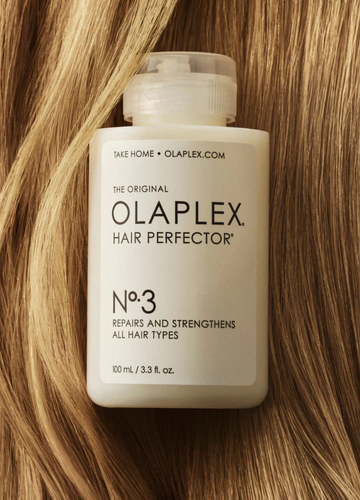Flaky scalp? Hair drama? Here's the shampoo every derm is obsessed with.
Hair drama hits different. One day your scalp’s thriving—the next you’re low-key wondering if it’s snowing... inside. Not cute.
We’ve all grabbed a random “miracle” shampoo in a panic, hoping for magic—only to end up with the same stubborn flakes, the same itchy scalp, and maybe even more hair swirling around the drain. Love that for us (not).
If your scalp’s been throwing silent protests, ketoconazole shampoo *could* be your secret weapon.
Originally created to fight fungus (SO glam), it’s now the insider go-to for tackling dandruff, calming scalp freakouts, and even supporting hair growth. Just imagine it as the skincare routine your scalp didn’t know it needed—but absolutely deserves.
We’re breaking down everything you need to know about ketoconazole shampoo. What it is, how it works, and why it might just be your hair’s new ride-or-die. Sit back and relax, girlie. Your best hair days are officially loading.
What is ketoconazole shampoo, really?
Okay, science moment, but stay with us.
Ketoconazole shampoo is basically the overachiever of the haircare aisle. It’s an antifungal formula designed to tackle the real villains behind dandruff, flaking, itchiness, and even some types of hair loss.
(Hint: the issue isn’t just dry skin—it’s often yeast or fungus throwing an uninvited party on your scalp.)
When your scalp's microbiome gets out of balance—stress, product buildup, or just bad luck, Malassezia (a natural yeast that lives on your skin) can go rogue. This causes some serious redness, itchiness, irritation, and flakes falling like confetti. That’s where ketoconazole steps in—quiet luxury for your scalp, keeping things calm and flake-free.
You’ll usually find ketoconazole shampoos in two strengths.
– 1% formulas you can grab over the counter are perfect if you’re dealing with mild scalp drama or want a maintenance moment.
– 2% formulas that are prescription-only are stronger, more intense, and ideal for bigger battles like stubborn seborrheic dermatitis or major hair shedding.
And here’s the catch: ketoconazole isn’t just a dandruff hero anymore. More and more derms are recommending it for people struggling with hair thinning and hair loss, too. When your scalp is inflamed or irritated, your hair follicles get stressed—and stressed follicles = slow growth, weaker strands, and, eventually, shedding.
By calming inflammation, balancing your scalp’s environment, and minimizing fungal overload, ketoconazole shampoo creates the perfect foundation for your healthiest, fullest hair yet. No gimmicks, no overnight miracle promises. Just science doing what science does best—and your scalp breathing a huge sigh of relief.
How ketoconazole shampoo works
Most shampoos show up, smell nice, and call it a day. Ketoconazole shampoo, though? She’s clocking in for real work. When you wash with a ketoconazole shampoo, you’re not just giving your hair a surface-level refresh—you’re breaking up the chaos at the root (literally).
Here’s what’s happening. On your scalp lives a yeast called Malassezia. When it overgrows, it triggers dandruff, inflammation, and a whole lot of irritation. Ketoconazole cuts through the noise, blocking the yeast’s ability to thrive and giving your scalp the reset it’s been begging for.
The benefits stack up fast.
– Less flaking and itching.
– A calmer, happier scalp.
– Healthier conditions for hair to grow stronger over time.
And while ketoconazole works deep at the scalp level, it’s also setting the stage for bigger wins—like fewer bad hair days, reduced shedding, and longer-lasting styles. Real recovery isn’t flashy, but it’s the difference between constantly battling your hair and enjoying it.
Consistency matters. Stick with it, pair it with your favorite nourishing products, and watch your scalp—and your hair—start acting brand new.
What ketoconazole shampoo can actually help with (and what it won’t)
Let’s get one thing straight. Ketoconazole shampoo is iconic—but it’s not a miracle potion brewed by fairy godmothers. It slays at what it’s designed for, but it’s not going to magically transform your hair into Rapunzel overnight. Setting realistic expectations = key.
Here’s what it can do for you
✨ Handle dandruff like a QUEEN
The number one claim to fame? Fighting dandruff—and winning. If your scalp has been flaking like a snow globe moment every time you touch your hair, ketoconazole helps reset your scalp by kicking out the yeast that causes all the drama.
✨ Soothe irritation and inflammation
If your scalp feels like it’s auditioning for a starring role in an itch-and-scratch commercial, ketoconazole steps in to calm things down. Less inflammation = less redness, less flaking, and way more comfortable vibes under your hair.
✨ Help with hair thinning (sometimes)
This is where it gets juicy. There’s low-key evidence that by calming scalp inflammation and keeping follicles clear, ketoconazole may indirectly boost hair density and help slow down shedding. Is it a replacement for full-on hair loss treatments? No. But can it support a healthy scalp environment that keeps your strands flourishing? Absolutely.
✨ Treat seborrheic dermatitis
If you’re dealing with more than just basic flakes—like redness, irritation, or greasy scaling—ketoconazole is the girl for the job. It’s basically skincare for your scalp, minus the 10-step routine.
Here’s what it won’t do (and that's okay)
🚫 Fix split ends or damage
Your split ends? Sadly, no shampoo can actually heal them (they're basically tiny hair fractures). You’ll need trims, not treatments.
🚫 Turn you into Rapunzel overnight
While it can set the stage for better growth, ketoconazole isn’t a hair-growth serum. If you’re after inches overnight, you’ll want to pair it with a serious growth plan (and maybe some extensions for the meantime, girlie).
🚫 Replace a solid haircare routine
You still need a good moisturizing conditioner, heat protectant, and gentle detangling habits. Ketoconazole doesn’t give you a hall pass for bad hair behavior.
Bottom line? Ketoconazole shampoo can be your scalp's personal trainer. It’ll whip things into shape, create a healthier foundation, and set you up for major wins—but you still have to show up for your hair with the full squad of good habits. Worth it? 1000%.
How to use ketoconazole shampoo (without wrecking your hair)
Go, girl. You’ve got your bottle of ketoconazole shampoo—now what? First things first. Don’t treat it like your regular 10-second rinse-and-go shampoo. This is scalp care, and it deserves VIP energy. Start by soaking your hair thoroughly with warm (not hot!) water to open up the cuticle and loosen any buildup.
Then squeeze out a quarter-sized amount (more if you’ve got lots of hair) and apply it straight to your scalp—not the lengths. Massage it in gently with your fingertips, not your nails (we’re not scratching lottery tickets here), and focus on the areas where you see the most flaking, redness, or irritation.
TYME tip: let it sit for at least 3–5 minutes to really let the ketoconazole work its magic. Trust—it’s worth it. You can vibe out, shave your legs, or belt out a Beyoncé ballad while you wait. After letting it soak, rinse thoroughly until you feel squeaky clean at the roots. Follow up with a hydrating conditioner or mask from mid-length to ends (because ketoconazole, while amazing, can be a little drying if you don’t balance it out).
If you’re using an over-the-counter 1% formula, aim for 2–3 times per week. If it’s a prescription-strength 2% formula, follow your derm’s advice to avoid drying or irritation.
A few bonus tips
– Don’t use ketoconazole shampoo daily—it’s a treatment, not your go-to daily cleanser.
– Alternate with a super moisturizing, sulfate-free shampoo to keep your hair and scalp happy.
– Avoid super hot water and high-heat styling if you’re fighting scalp issues—it just adds fuel to the fire.
– Consistency is key—scalp health is a marathon, not a sprint. Stick with it for a few weeks to start seeing major changes.
Basically, using ketoconazole shampoo the right way means getting strategic, not rushing, and treating your scalp like the bad B it is.
How often should you use ketoconazole shampoo?
Trust us, more isn’t better when it comes to ketoconazole shampoo—it’s about consistency, not obsession. If you're reaching for an over-the-counter 1% formula (like Nizoral), most derms recommend using it 2–3 times a week. That gives your scalp time to soak up the benefits without overdrying your hair or causing irritation. If you scored a prescription-strength 2% formula, it’s a little more intense—so your dermatologist might tell you to stick to once or twice a week or even less, depending on your scalp’s condition.
The golden rule? Always balance it with your usual, gentle shampoo on the off days. Think of ketoconazole shampoo like a deep-cleaning facial for your scalp: you wouldn't do an acid peel every single day, right? Same energy. You want to give your scalp time to heal, rebalance, and thrive without stripping away all the good stuff.
Also, pay attention to how your scalp feels and looks.
– If you notice redness, itchiness, or excessive dryness, take a break and scale it back.
– If your dandruff, flaking, or irritation eases up after a few weeks, you might be able to switch to maintenance mode (once a week or even every other week).
– If you’re using it to support hair growth goals, stick with your derm’s game plan—and remember, patience pays off. Hair health is a slow-burn transformation, not an overnight glow-up.
Does ketoconazole shampoo work for everyone?
Here’s the honest tea: ketoconazole shampoo is powerful, but it’s not a one-size-fits-all magic trick.
If you’re dealing with classic scalp drama like dandruff, seborrheic dermatitis, or mild hair shedding, you’ll probably see major wins after a few weeks. Less itch, less flake, way more hair confidence.
BUT if your scalp issues are triggered by something deeper—like autoimmune conditions, hormonal imbalances (hi, PCOS girlies), or serious medical hair loss like alopecia—ketoconazole alone might not cut it. It can help support scalp health, but it’s not a cure-all. In those cases, it’s more of a “supporting character” alongside dermatologist-led treatments. Also, if you’ve got ultra-sensitive skin or color-treated hair, just a heads up—ketoconazole can be drying. That’s why it’s key to follow with hydrating conditioners, masks, and gentle wash routines. Balance is your BFF.
Long story short
✅ Great for mild-to-moderate scalp issues
⚡ Best when paired with a healthy haircare routine
🚫 Not a replacement for pro-level treatments if you have major hair loss or scalp conditions
Ketoconazole shampoo is like the friend who’s always there to help—but sometimes you’ll need a full glam squad to get the results you’re dreaming of. Know your scalp, know your goals, and plan accordingly, babe.
Why ketoconazole shampoo deserves a spot in your shower
If you’ve been side-eying your flaky scalp, stressed-out strands, or shedding drama, ketoconazole shampoo is your new non-negotiable. It's dermatologist-approved, TikTok-hyped, and does the heavy lifting—without the gimmicks.
No matter if you’re battling dandruff, calming scalp inflammation, or even giving your hair growth goals a subtle boost, this ingredient doesn’t just sit pretty on a label. It works. And it’s one of the easiest, low-effort upgrades you can make to your routine (we love a main character moment that's totally attainable).
The real takeaway? Healthy hair always starts at the scalp—and ketoconazole knows how to set the scene. Just remember: consistency is important, AND choosing the right formula matters. So, next time you’re lining up your hair wash line-up, you’ll know exactly what deserves a spot in your shower.





